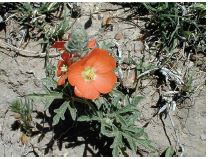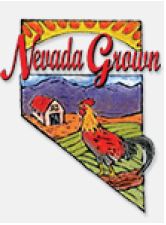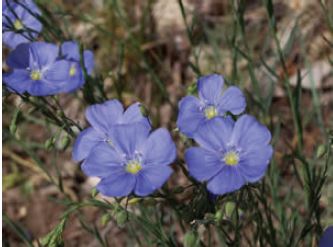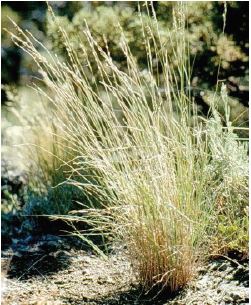Introduction
As water resources in the Western U.S. decline, both residential and commercial landowners are increasingly encouraged through both rising water costs and governmental incentive programs to adopt water-conserving landscape strategies. Such strategies often include xeriscaping, which includes principles such as landscape design, soil evaluation, water system efficiency, proper maintenance, and most importantly, the use of low water use vegetation, such as native plants. In 2004, a study was conducted to examine the market in Nevada for locally produced native plants and seeds. As part of the study a survey was mailed to homeowners in the Reno, Henderson, and Las Vegas areas to determine consumer preferences for and usage of native plants and seeds. A total of 250 valid surveys were returned from homeowners, with 65% of the responses coming from residents of northern Nevada, and the remaining 35% from southern Nevada.
The respondents of this survey were asked questions related to their knowledge of and preferences for native plants and seeds, the results of which are described here. Respondents were also asked questions relating to their willingness to pay for locally grown native plants and seeds. The results of that portion of the survey can be found online at University of Nevada Cooperative Extension’s website as Fact Sheet-07-17, titled “Nevada Consumers Willing to Pay More for ‘Nevada Grown’ Labeled Native Plants.”
What Makes a Plant "Native"?
Plants are considered to be native if they were naturally occurring in a region prior to European exploration. In addition to creating a more natural appearing landscape, native plants are important because they are adapted to the climate and ecosystem of their area, and may restore or encourage the health of the region.
Examples of plant species native to Nevada include Indian ricegrass, Great Basin wild rye, scarlet globemallow, shadscale, and Western yarrow.
Benefits of Using Natives in Nevada
Certain native plants provide protection against invasive species, an issue of increasing concern in Nevada. Natives may also help to combat soil erosion, a feature that is especially important in Nevada’s high desert climate, which is characterized in part by highly erodible soils.
Another important characteristic of Nevada's native plants is their resistance to drought. Natives are adapted to Nevada’s sparse precipitation and require little water to survive, meaning they will have better odds of surviving hot, dry summers and will not require as much water as many non-native species. This is particularly important in Nevada, as the state has a limited supply of water. The benefits of landscaping with native plants are therefore twofold for Nevada residents: native plants put less of a strain on the region's resources, and are more cost-efficient as water prices increase.
Additionally, some of Nevada's native plants are less susceptible to drying out than non-natives, providing a degree of fire resistance. In turn, fire resistance helps to prevent the new growth of invasive species that is common following a fire, thus reducing the spread of invasive species.

Survey Results: Plant & Supplier Characteristics
To gain an understanding of the characteristics of plants and plant suppliers that appeal to residents of Nevada, respondents were asked to rate the influence of several plant and supplier characteristics (Table 1).
1. Price
The price of the plant product was given one of the highest influence ratings among survey respondents, with 48.3% of respondents listing price as a more influential attribute when considering a plant product purchase.
2. Quality
The quality of the plant product was tied with price as being the most influential factor. As with price, nearly half of respondents, 48.3%, rated quality as a more influential factor. The fact that price and quality were given the same rating by just under half of the respondents indicates that respondents are not motivated by price alone. If a plant product is of a high enough level of quality, customers may be willing compromise on price.
Table 1: Plant & Supplier Characteristics
| Plant/SupplierAttribute |
% Ranked more influential |
| Price |
48.3% |
| Quality |
48.3% |
| Selection |
47.9% |
| Location of supplier |
43.1% |
| Service from supplier |
18.5% |
| Community support |
13.7% |
3. Selection
Respondents were asked to rate the influence of a supplier having a wide variety of plants available. This supplier attribute was given a more influential rating by 47.9% of respondents, indicating that providing a wide selection of products carries a modest amount of influence among respondents.
4. Location
The location of the supplier's facility was only rated slightly lower than the supplier's selection, with 43.1% of respondents rating location as a more influential attribute. This makes sense intuitively, as customers will probably not want to travel great distances for their landscaping and gardening supplies.
5. Service
Ranked much lower than the other characteristics was the service received from a supplier. While service was not found to be as influential to respondents as other factors, it is important to note that 18.5% of respondents felt this was a more influential factor.
6. Supporting the Local Community
Providing support for the local community received far lower influence ratings. While only 13.7% of survey respondents rated supporting the local community as a more important characteristic, for locally-owned plant supply outlets, this is a fairly well-sized niche market. Customers who are interested in supporting their local community may be willing to pay a premium for products they can purchase from a local supplier.

Survey Results: Native Plant Features
In an effort to determine which features of native plants appeal most to residents of Nevada, survey respondents were asked to rate the importance of four major benefits of native species (Table 2). These included drought resistance, natural appearance, protection from invasive species, and erosion control.
1. Drought resistance
A key feature of many plants native to Nevada is their natural resistance to drought. Because these species are native to Nevada, they are suited to the harsh conditions that characterize much of Nevada's high desert climate, including low moisture and extreme sun exposure. Resistance to drought provides a measure of resistance to fire, and perhaps more important to homeowners in Nevada, means these plants will require less water and maintenance than many non-native species. Less water usage may be a motivating factor for Nevada's residents as water prices increase, and may appeal to some consumers who wish to minimize their use of Nevada's limited water supply for landscaping purposes. This study found that 75.8% of respondents rated drought resistance as a more important feature of native species.

2. Natural appearance
Because native plants are by definition native to the region, using them in landscaping creates a more natural-looking environment. Survey respondents ranked natural appearance as the second most important feature of native plants, with 60.2% of respondents rating it as a more important feature.
Table 2: Native Plant Features
| Native Plant Feature |
% Ranked more important |
| Drought resistance |
75.8% |
| Natural appearance |
60.2% |
| Protection from invasives |
40.8% |
| Erosion control |
22.7% |
3. Protection from invasive species
One of the many ways native plants provide protection from invasive species is through the provision of fire resistance. Wildfire prevention is essential to limiting the post-fire invasion of weed species that is common in Nevada. Additionally, because many native plants are dense, it is difficult for invasive species to grow in and around them, meaning areas with certain natives present are less likely to be intruded upon by invasive species. Survey respondents ranked protection from invasive species as the third most important feature of native plants, with 40.8% of respondents rating this as a more important attribute.

4. Erosion control
The sandy, quick-draining soils present throughout most of Nevada are prone to erosion due to high winds, fire, and flash floods. The root systems of native plants can help to control erosion, making them an appealing landscaping choice for homeowners concerned with erosion. Erosion control was given the lowest importance ranking among survey respondents, although nearly a quarter of respondents, 22.7%, rated erosion control as a more important attribute.
Conclusions
Native plants can be beneficial to homeowners in Nevada for several reasons, including drought and fire resistance, their natural appearance, erosion control, and protection from the intrusion of invasive species. A 2004 survey of Nevada's homeowners found that consumers feel drought resistance and natural appearance are the most important features of native plants, while price and quality were found to have the most influence on respondents’ plant product purchasing decisions. A portion of survey respondents also expressed an interest in supporting the local community, indicating that there is room for local suppliers to service this niche market.
Notes
Xeriscape landscaping, by definition, is landscaping designed specifically for areas that are susceptible to drought or for properties where water conservation is practiced. Derived from the Greek xeros meaning "dry," the term, xeriscape means “dry landscape.” Xeriscape landscaping needn't be limited to desert plants, such as cacti. Rather, a xeriscape landscaping policy allows for the use of many plant varieties, but insists on common-sense measures that will help conserve water, such as grouping plants with similar water requirements together. A common element in xeriscape landscaping is the reduction of grass areas, since grass is one of the worst water conservation offenders (Beaulieu, 2007).
More Information
For more information on niche marketing, value added agriculture, invasive species and native species, visit University of Nevada Cooperative Extension online at UNCE.
References
References Beaulieu, David (2007). “Xeriscape Landscaping.” Available at: The Spruce.
Curtis, K.R., M.W. Cowee, and S.L. Slocum, (2005). “Nevada Wildland Seed Cooperative Feasibility Assessment.” University of Nevada Center for Economic Development (UCED) Publication 2005/06-10.
McAdoo, J.K., Johnson, W.S., Wilson, R.E., Donaldson, S. and Graham, J. (2005). “Fighting Invasive Weeds-A Northern Nevada Landowners Guide to Healthy Landscapes.” UNCE Extension Bulletin EB-05-02.
Cowee, M. and Curtis, K.
2007,
Native Plant Characteristics Appeal to Consumers in Nevada,
Extension | University of Nevada, Reno, FS-07-16


